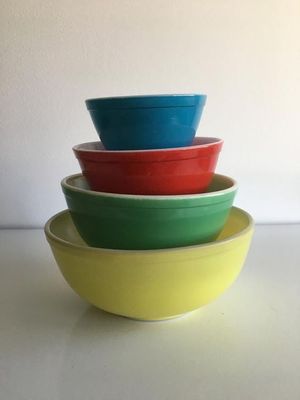If you have spent much time around the kitchen during your lifetime, you have most likely had some kind of Pyrex in your hand! If you haven’t eaten popcorn in that large Pyrex mixing bowl, you have undoubtedly eaten a meal made in a Pyrex casserole dish. The cook probably even used a Pyrex measuring cup to make it. This is a small testament to how much Pyrex is used in the U.S. and how long it has been around. Many people would be shocked to walk into any random kitchen in the United States and find that it doesn’t have at least one piece of Pyrex in the cupboards!
The history or Pyrex is very interesting indeed. Pyrex was “invented” in 1915 by Corning in Corning, New York. Heat resistant glass already existed at the time, but it was mainly used in science lab experiments and railroad lantern glass. The aha moment came when a Corning scientist’s wife wondered if she could cook with the heat resistant glass. He wanted to find out how well it would work, so he cut a piece for her to try. As you may guess, it worked so well that Corning went forward with a product geared towards the residential market that revolutionized kitchens all over the world.
It was featured in magazines like Good House Keeping Magazine early on, but wasn’t widely used or affordable for almost 2 decades due to costs. As a child, I remember my grandmother having some green bowls I thought were “tacky” at the time. I now know this wonderful pattern as Pyrex Gooseberry print created in 1957. She had lots of different Pyrex pieces including Cinderella Bowls (1957) that held all of her vegetables on the dinner table and Snowflake Print (1956) casserole dishes which I was lucky enough to inherit.
Even though I have owned Pyrex for over 20 years, it wasn’t until a few years ago that I really started actively collecting and trying to be the first in line at an estate sale. I am always looking for the entire set of Primary Mixing Bowls (1945) or that one small red refrigerator dish (1948) I needed to complete my set. It really amazes me how much value Pyrex holds. A set of Pyrex Primary Mixing Bowls that was originally sold for $2.95 was $50.00 a few years ago and now it can sell for $100.00 or even more. For those who only want to collect antiques, Pyrex also fits the bill since the 100th anniversary occurred in 1915. These days, when someone says Pyrex, my Aunt and I are the first ones in the car. We love collecting multiple prints, colors, shapes, sets and sizes. We try to go vintage Pyrex shopping weekly. Our destinations are always Antique Stores, Flea Markets, Thrift Stores, Estate Sales and of course Garage Sales. My Aunt is also always on the hunt for lids since lots of vintage Pyrex have lost theirs over the years. If we see a piece we love, we buy it because there will eventually be a store that has the perfect size for the Pink Daisy Pattern Oval Casserole Bowl (1956) or the Dots Pattern (1967) that I’m after.
Pyrex hunting has not only been a fun hobby for me, it sometimes gets competitive with my mom and aunts! On one trip in particular, we headed to an antique mall that always had great Pyrex at affordable prices. As I pulled into the parking lot, my Aunt had the car door opened and jumped out before I could put the car in park! By the time the rest of us had gathered our purses and drinks and walked inside, she was almost ready to check out. She was on a mission to get the first great deal on the Pyrex that day and she got it! We love the hunt and tend to view Pyrex collecting as a retirement enhancement hobby. Our hopes are that it will always be fun to collect items that not only retain their value over time, but hopefully will increase as well. If the history of Pyrex through the first 100 years is any indication, we are definitely on the right path. So, if you hear of any Vintage Pyrex you better go start the car!

